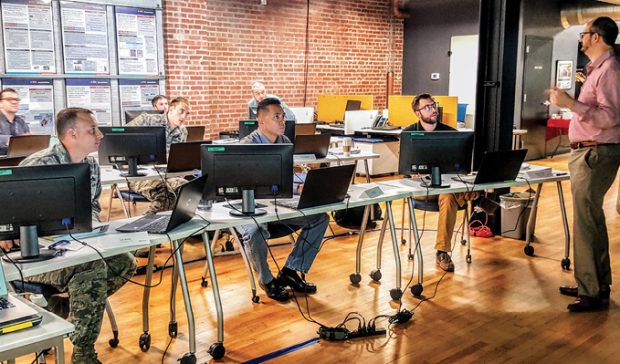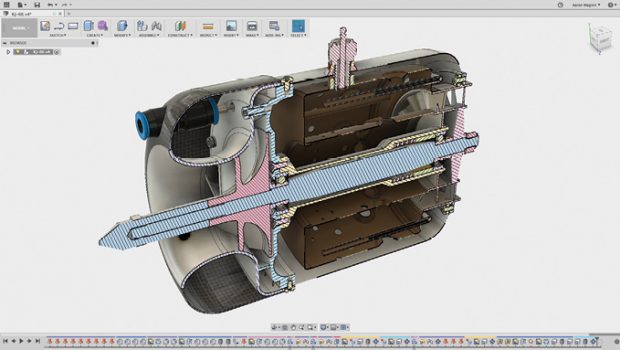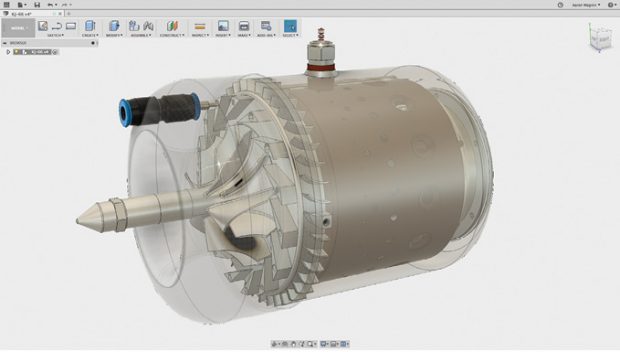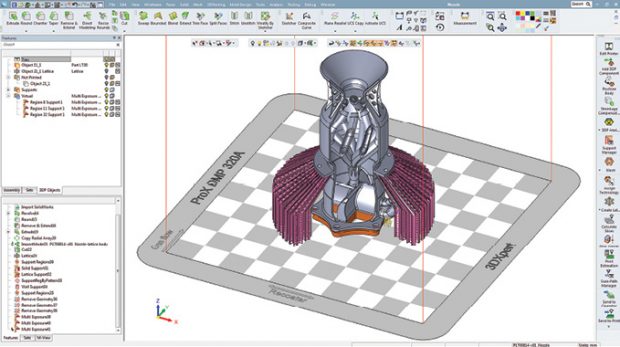A Campaign to Train Tomorrow’s Workforce

Anthony Hughes leads a course on Design for Additive Manufacturing at the America Makes facility. Image courtesy of Autodesk.
Latest News
April 1, 2018
As additive manufacturing (AM) gains traction across diverse industries in both public and private sectors, its rapid growth has generated a not-so-minor deficiency: There’s an absence of skilled professionals to meet the demand.
That’s why organizations such as The Lanterman Group (a 3D printing innovation strategy and design firm) and America Makes (a collaborative partner in AM/3D printing technology and workforce development) have stepped up to the plate with a training program to try to offset any future shortage.
 Anthony Hughes leads a course on Design for Additive Manufacturing at the America Makes facility. Image courtesy of Autodesk.
Anthony Hughes leads a course on Design for Additive Manufacturing at the America Makes facility. Image courtesy of Autodesk.Together, they are offering what’s called ACADEMI (the Advanced Curriculum in Additive Design, Engineering and Manufacturing Innovation), which was created to encourage the transfer of business and technical know-how to industry.
It’s about “creating [a] national additive manufacturing educational program to train the next generation of workforce,” according to America Makes’ ACADEMI-devoted page on its website.
 3D Systems says the ProX DMP 320 direct metal printer combined with LaserForm metal materials offer reduced waste, greater production speeds, short setup times and dense, pure metal parts. Image courtesy of 3D Systems.
3D Systems says the ProX DMP 320 direct metal printer combined with LaserForm metal materials offer reduced waste, greater production speeds, short setup times and dense, pure metal parts. Image courtesy of 3D Systems.ACADEMI represents a partnership of The Lanterman Group, founded by Anthony Hughes to help manufacturing executives and organizations grow through the adoption of manufacturing technologies; and America Makes, a public-private partnership with members representing industry, academia, government, non-government agencies and workforce, along with others in the industry that are providing equipment, software and support.
“ACADEMI is an innovative and multidisciplinary training program focused on engineering and manufacturing innovation in additive manufacturing (AM) technologies, applications and processes,” explains Hughes, president of the Chagrin, Falls, OH-based The Lanterman Group. “ACADEMI has been shaped by input from over 100 companies and over 30 subject matter experts from across industry and academia.”
Its primary focus is design for additive manufacturing (DfAM). Courses within the ACADEMI portfolio will address taking an industry application through all or parts of the DfAM workflow (e.g., value identification, part selection, material selection, lattice structure design and post-processing). Additionally, coursework includes hands-on opportunities with software and equipment during lab periods.
 A cross-section of the microturbine that students rebuilt using additive manufacturing techniques throughout the course. Image courtesy of Autodesk.
A cross-section of the microturbine that students rebuilt using additive manufacturing techniques throughout the course. Image courtesy of Autodesk.The targeted audience for ACADEMI training, according to The Lanterman Group, includes design engineers, manufacturing engineers and material science engineers who wish to develop skills from a holistic, integrated set of AM disciplines.
 Fusion 360 was used in the design and validation of the microturbine used in many of the lessons. Image courtesy of Autodesk.
Fusion 360 was used in the design and validation of the microturbine used in many of the lessons. Image courtesy of Autodesk.Those who stand to benefit: “Companies that desire a workforce who can cross disciplinary boundaries, such as materials science, mechanical engineering and manufacturing engineering. These learners will be key enablers for a stronger AM design community,” Hughes adds.
How and Why it Got Rolling
The ACADEMI program initially emerged as the result of insights from an America Makes additive manufacturing and 3D printing workforce and education roadmap. For background and context, three separate studies were done between 2015 and 2016. (TLG and Bush Consulting Group did the work.)
 3DXpert design for metal additive software delivers a range of tools to prepare 3D design data for metal additive production including optimization of supports, zoning, addition of lattice work, build simulation and more. Image courtesy of 3D Systems.
3DXpert design for metal additive software delivers a range of tools to prepare 3D design data for metal additive production including optimization of supports, zoning, addition of lattice work, build simulation and more. Image courtesy of 3D Systems.“While training in the industry exists, training aligned toward specific requirements (or needs) in the member-driven, public-private roadmap was lacking,” says Rob Gorham, executive director of America Makes.
Hughes adds: “While companies and government organizations are beginning to utilize the new technology and manufacturing processes, there is not a skilled workforce of trained professionals to support the industry.”
Coinciding with the needs that the roadmap uncovered, the industry has been vocal in seeking deeper training and acknowledging a lack in workforce skills tied to production of commercially ready additive manufacturing products, Hughes notes. He highlights specific weaknesses in current AM-specific training:
- tends to be superficial when linking AM process, materials, machines and part quality;
- lacks integration of diverse disciplines, including advanced concepts such as materials, process, design simulation, biomimicry and reverse engineering;
- often fails to connect the AM processes to the economic/business case; and
- leans toward training environments that can be more theoretical and lecture-based than hands-on and application-based.
Nuts and Bolts of ACADEMI
ACADEMI is designed to create what Hughes calls an “immersive, hands-on training environment” by fusing skills from different disciplines into a design-for-additive manufacturing (DfAM) portfolio of classes.
“The ACADEMI does cover general knowledge of AM, but mainly focuses on design for additive manufacturing workflow, which is one of the major obstacles to widespread adoption of the technology. 3D Systems sees significant value in sharing our experiences in designing for additive manufacturing,” says Jared Blecher, Aerospace & Defense engineer, 3D Systems. 3D Systems is one of the industry leaders actively involved in the ACADEMI program.
Autodesk’s Aaron Magnin further describes the ACADEMI program as a weeklong immersive “bootcamp”-style training course that covers all aspects of the additive manufacturing process.
“Starting with the design, attendees are presented with a wide array of considerations required to address DfAM. To properly understand this, deep dives in different additive processes and technologies will be presented—and used—by the multidisciplinary attendees,” Magnin adds.
A key differentiator, says Hughes, is that “we develop the content and curriculum, and coordinate its delivery in conjunction with membership, including equipment providers, training content providers and other industry partners.”
Suppliers Already Plugged In
A couple equipment and software providers for ACADEMI weighed in on their companies’ involvement.
Blecher of 3D Systems, says his company has worked with ACADEMI from the get-go.
The first ACADEMI class, according to Blecher, was funded through America Makes by the Air Force Research Laboratory (AFRL) as a part of an effort to contribute to the development of a workforce capable of accelerating advanced engine and material transition development.
“As a subcontractor in the project, 3D Systems assisted The Lanterman Group in developing content for the weeklong class in October 2017,” Blecher says.
Currently, for its role, 3D Systems works with students by covering the ProX DMP 320, 3DXpert, design of parts for powder bed fusion additive manufacturing and operation of metal 3D printers.
3D Systems is also supporting the ACADEMI program by sending a Ph.D.-level scientist to provide instruction on the operation of the ProX DMP 320, according to Blecher. The company is sending a ProX DMP 320 and 3DXpert super-user for hands-on instruction of 3DXpert and as a resource for designing for additive manufacturing including support, lattice and feature design. In addition to personnel, 3D Systems has provided temporary software licenses so that students can learn in 3DXpert.
Autodesk’s Magnin says Autodesk’s collaboration with ACADEMI has been an ongoing effort since December of 2016.
“We’ve been involved since its inception by providing both software and the technical expertise to accompany it in the development of curriculum,” Magnin says.
Autodesk offered ACADEMI instructors its catalog of software offerings. “After careful consideration they opted to use Fusion 360 for most all of the design portions and some simulation, and of course Netfabb Ultimate to cover additive processes,” Magnin says. In addition to the software, he says Autodesk has assisted with curriculum development and delivery at RAPID and the inaugural run of ACADEMI.
“We are committed to providing new software as it matures, such as Autodesk Generative Design, and will help keep the ACADEMI curriculum up-to-date with Netfabb enhancements, as it rapidly adapts to industry requirements,” he says.
How ACADEMI Complements University Curriculum
Some of ACADEMI’s collaborators are from universities, so ACADEMI leadership is working to help “speed information from their existing longer-term efforts into ours,” Hughes says.
Additionally, there is discussion of integrating ACADEMI into existing university facilities focused on continuing education, though specifics were not available at press time.
2018 Goals and Expansion Plans
Though the goal list is lengthy, following are some larger initiatives for this year, according to Hughes:
- leverage the existing ACADEMI operating model, course offerings, content, sustainability model and cost share contributions already developed for America Makes membership;
- deliver a metal DfAM class for general registration, starting in early spring;
- develop a new course offering to meet the gaps/needs defined in the America Makes-led DoD roadmap work by working with DoD stakeholders to identify training needs affecting greater AM adoption within acquisition, requirements and sustainability programs; and
- deliver the new course offering to two DoD partners, e.g., The U.S. Army, Department of the Navy, U.S. Air Force, and Defense Logistics Agency, Air Force Research Laboratory, Systems Engineering and Special Operations Command.
In 2018, ACADEMI’s course offerings will be expanded by working with other industry partners, Manufacturing USA Institutes and Department of Defense partners, according to Hughes.
“We plan to add to the existing manufacturing curriculum around identified gaps within the advanced manufacturing education portfolio that America Makes partners have identified. Expanded course offerings are intended to be offered as continuing education and on-the-job training for industry and DoD partners,” Hughes says.
Regarding the future, Hughes says ACADEMI serves as a foundational platform that will “enable us to plan more directed hands-on training efforts inside and outside of its membership (i.e., satellite centers, universities, community colleges, vocational/technical schools, etc.).”
Autodesk’s Magnin adds the ACADEMI initiative is a must-have for the industry.
“We see this initiative as being crucial to help prepare industry leaders for the looming paradigm shift in manufacturing. Additive manufacturing has the potential to transform the way we make things, but designers’ approaches need to be retooled to leverage these processes, and new constraints need to be factored in as well.”
By Stephanie Skernivitz
More Info
Subscribe to our FREE magazine, FREE email newsletters or both!
Latest News
About the Author
Stephanie is the Associate Editor of Digital Engineering.
Follow DE





